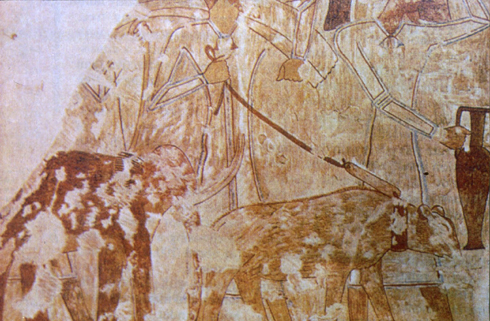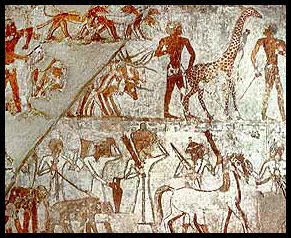Woolly Mammoths among the Pharoahs? April 14, 2011
Author: Beach Combing | in : Ancient, Medieval , trackback
**This post is dedicated to Andy the Mad Monk who put Beachcombing onto it**
Beachcombing has long wondered if the publishing world would not have room for a volume on long-travelled exotic animals in Antiquity and the Middle Ages: giraffes turning up in Renaissance Italy; polar bears being brought down to the medieval Arabs; camels in Merovingian Gaul; some of the living furry bait that the Romans used in their gladiator fights; turkeys sailing across from the Americas etc etc. After all, transferred beasts represent an unusual form of trade: one that requires handlers, feed, special transport facilities: perhaps a good general rule is that if animal z can be moved from country x to country y, then objects, people and ideas will also be able to cover the same distance regularly?
A fine example of animals being brought from afar appears in c. 1400 BC in the wall decorations from the celebrated mortuary chapel – not tomb – of Rekhmire at Thebes. On the wall there are two rows of tribute being brought to the Egyptian master-race. On the top we have ‘Nubians’ and their gifts – including a far travelled giraffe. Then on the second line we have ‘Syrians’ and a bear (or lion?) and a baby elephant.
This ‘baby’ elephant has been the cause of much controversy – (follow the link for an excellent discussion), not least because its tusks seem quite remarkably mature. Then, even more problematically, this ‘baby’ seems to have a coat of fur. It has even been suggested that this may be a dwarf woolly mammoth!
Yikes.
From here it was just a short step to positing a trade network between Egypt and ancient Siberia, shuttling woolly mammoths across the steppes to the court of the pharaohs. Beachcombing should add that there is no definite evidence that woolly mammoths survived this late in Asia.
Given that the creature in question is associated with folk from the Levant then the easiest solution is that this is an immature elephant from there that had been stylised with tusks – an elephant with immature tusks might not seem like an elephant in graphic terms.
However, there has also been the suggestion that this was a Mediterranean pygmy elephant from one of the Mediterranean islands, that might, on the basis of some very doubtful but intriguing evidence, have survived into times of human habitation. Note though they would have needed to survive another three thousand years to get them to the vizier’s Egypt and Beachcombing doubts that the locals would have been able to resist wiping out this breed. Certainly, he’d love to have a head over the fire-place. Then there is the problem of whether they were really hairy…
Beachcombing is always on the look out for far-travelled animals: drbeachcombing AT yahoo DOT com
***
30 April 2011: Judith Weingarten took up the challenge: The baboons from Eritrea: ‘The Egyptians were not good sea sailors. Navigating the dangerous waters of the Red Sea to the very edge of the known world must have seemed to them as daunting as a mission to the Moon to us.’ And to the poor baboons, too… Thanks to Judith!!



